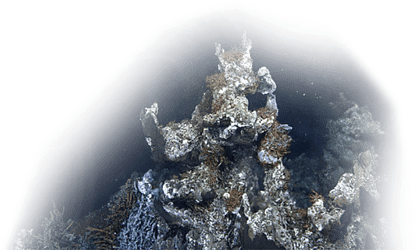NEWS RELEASE
Ocean Networks Canada (ONC) has recorded the highest daily average summertime temperatures at two of its seafloor observatory sites in the northeast Pacific Ocean since continuous live monitoring started there in 2009.
ONC, a University of Victoria initiative, operates the North-East Pacific Time-series Undersea Networked Experiments (NEPTUNE) observatory that powers scientific instruments and thousands of sensors, providing real time ocean conditions data. The 800-kilometre NEPTUNE cabled observatory is located off the west coast of Vancouver Island.
Figure 1: Part of ONC’s 800+ kilometre NEPTUNE cabled seafloor observatory that provides continuous live ocean data accessible through the Oceans 3.0 data portal on the ONC website.
ONC senior scientist Kohen Bauer says recent state-of-the-ocean data show that two NEPTUNE sites located on the continental shelf of the northeast Pacific Ocean have been recording high temperatures this summer.
“Temperatures climbed steadily throughout July at ONC’s 95-metre water depth Folger Deep site within Folger Passage, eventually surpassing the highest daily average temperature recorded there for early August since ONC’s monitoring began 14 years ago,” he says.
“Additionally, further offshore at the Barkley Upper Slope site (roughly 400-metre water depth) record seasonal temperatures have mostly persisted since June, largely exceeding the 14-year daily average temperature range at that location. This reveals that even deeper waters at the shelf's edge are anomalously warm for this time of year."
For example, on Aug. 10, a new daily average temperature high of 8.57 Celsius (°C) was reached at Folger Deep, compared to the previous 14-year record for that date of 8.44 °C. On the same day at Barkley Upper Slope, a new record of 6.01 °C was reached, compared to the previous high of 5.90 °C on that date.
ONC scientific data specialist Stef Mellon evaluates the quality of the data coming from NEPTUNE’s many underwater instruments. She says the anomalous summer ocean temperatures at Folger Deep alerted the data analytics and quality team to conduct extra analyses, and multiple instruments have confirmed the data. [See State of the Ocean plots Figure 2 and 3]
Bauer says there could be a number of possible factors causing warmer summer waters at different locations in the northeast Pacific Ocean, including excess heat from climate change, changes in wind patterns, and variations in the upwelling of deeper waters.
“We live in a time of Earth system extremes, with record global air and ocean temperatures emerging as a major concern. Temperature plays a key role in many interconnected processes in the ocean, and although the mechanistic drivers of the warm summer temperatures we are seeing on the NEPTUNE observatory may not persist, it is worth investigating in more detail. Such observations highlight the importance of ocean monitoring networks in helping us understand these rapidly changing environments.”
Figure 2: State of the Ocean plot for Folger Deep. The magenta line shows this current year’s daily averages for sea water temperature compared to the overall daily average for 14 years (black) and daily averages from every year from 2009-2022 (grey). The red and blue lines represent the day of year average plus and minus 1 standard deviation, respectively.
Figure 3: State of the Ocean plot for Barkey Upper Slope in Barkley Canyon. The magenta line shows this current year’s daily averages for sea water temperature compared to overall day of year averages (black) and daily averages from every year (grey) since monitoring began in 2009. The red and blue lines represent the day of year average plus and minus 1 standard deviation, respectively.
This research is supported by the Canada Foundation for Innovation and the Government of Canada's Oceans Protection Plan. It also aligns with United Nations Sustainable Development Goal (SDG) 14, or life below water.
A media kit containing images, graphs, a map and video is available on Google Drive.
Media contacts:
Robyn Meyer (Ocean Networks Canada Communications Manager) at 250-588-4053 or onc-comms@uvic.ca
Jennifer Kwan (University Communications + Marketing) at 236-638-2113 or uvicnews@uvic.ca
Kate Moran (Ocean Networks Canada) at 250-812-1575 or kmoran@uvic.ca
About Ocean Networks Canada
Ocean Networks Canada (ONC) operates world-leading observatories in the deep ocean, coastal waters and land of the Pacific, Atlantic, and Arctic coasts of Canada, collecting ocean data that accelerates scientific discovery and makes possible services and solutions for a resilient planet. ONC’s cabled observatories supply continuous power and Internet connectivity to scientific instruments, cameras, and 12,000-plus ocean sensors. ONC also operates ocean mobile and land-based assets, including coastal radar. ONC is an initiative of the University of Victoria.
About the University of Victoria
UVic is one of Canada’s leading research-intensive universities, offering life-changing, hands-on learning experiences to more than 22,000 students on the edge of the spectacular BC coast. As a hub of transformational research, UVic faculty, staff and students make a critical difference on issues that matter to people, places and the planet. UVic consistently publishes a higher proportion of research based on international collaborations than any other university in North America, and our community and organizational partnerships play a key role in generating vital impact, from scientific and business breakthroughs to achievements in culture and creativity. Find out more at uvic.ca.
Header image: Ocean Networks Canada deployment of instruments used for ocean monitoring – CTDs (Conductivity, Temperature, and Depth). Credit: Ocean Exploration Trust
